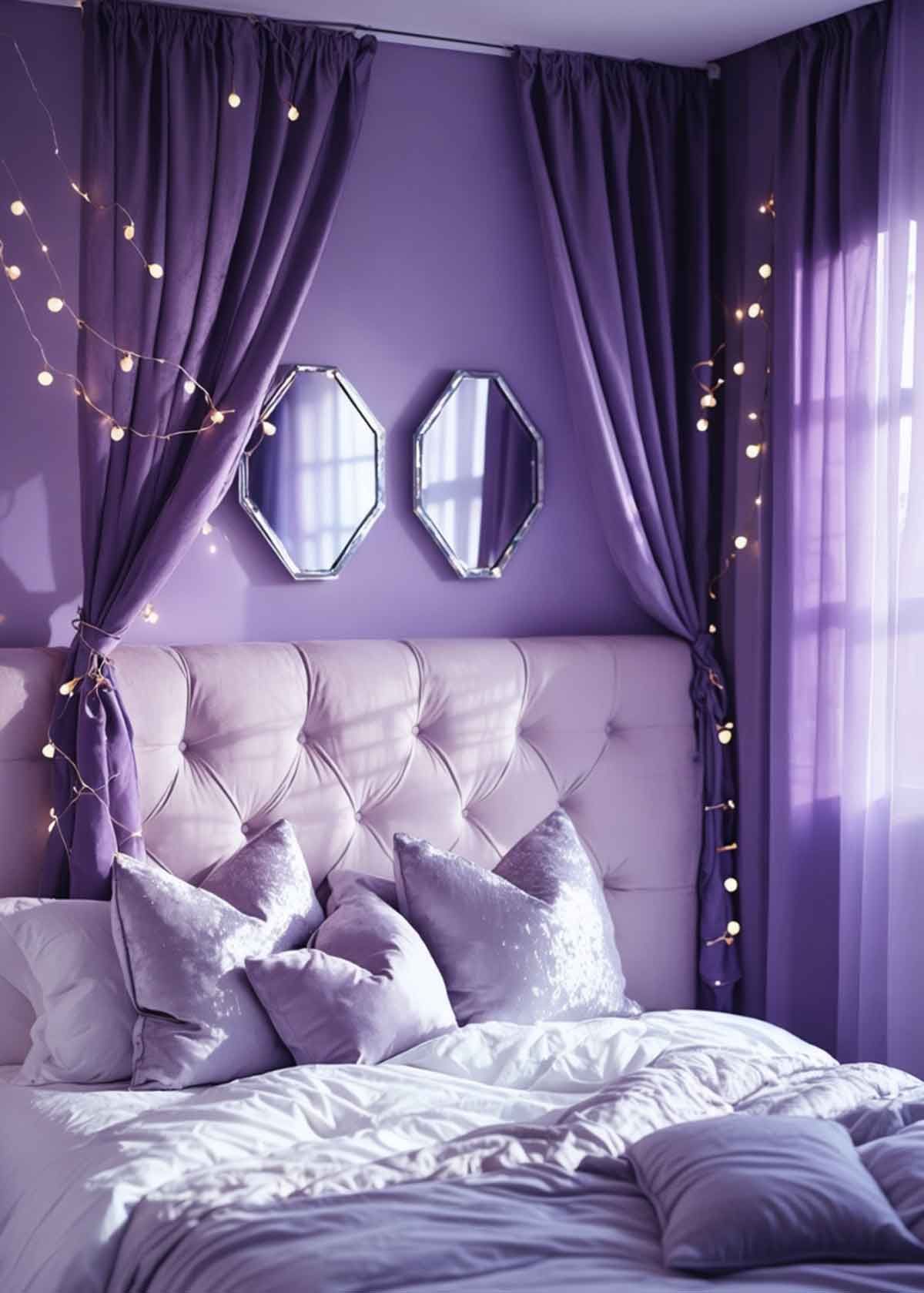5 Space-Saving Tricks for Kids' Bedrooms
Make The Most Of The Space In Your Child's Bedroom
Many Australian families struggle to make small children's rooms work. It's a big challenge, but I've got solutions.
Walking into your child's room can feel overwhelming. Toys and clothes seem to grow overnight.
But, even the smallest room can be organized with the right tricks.
In this guide, I'll share five space-saving tips that work in Australian homes. From Melbourne to Byron Bay, these tricks turn small rooms into organized spaces. They're not just ideas; they're real solutions for busy families.
These tricks can help, whether your room is tiny or you just want more space. They'll help you and your kids have a more organized bedroom.
Understanding Space Challenges in Children's Bedrooms
Kids' bedrooms face special storage challenges that parents often don't see coming. Unlike adult rooms, which have one main use, kids' rooms are for sleeping, playing, studying, and storing things. This makes them a busy space.
Kids collect a lot of stuff, from small Lego pieces to big sports gear.
Australian families often give the smallest room to their kids, thinking they need less space than adults.
This leads to a lot of clutter. I've seen many kids' rooms where toys, books, clothes, and art supplies fight for space.
"Children's items may be small in size, but they create the biggest organizational challenges in any home."
The main issue isn't just how much stuff there is. It's also about how kids can reach their things easily. Adult storage solutions don't work for little hands because they're too high or complicated.
Traditional storage for kids' rooms doesn't fit how kids use their space. They play, change clothes, and read books, making a mess.
Effective space saving for kids' bedrooms means using systems that fit their natural ways of using space.
| Room Function | Storage Challenge | Common Problem | Impact on Space |
|---|---|---|---|
| Sleeping Area | Bedtime comfort items | Stuffed animals everywhere | Cluttered bed space |
| Play Zone | Quick toy access | Toys left scattered | Floor space unusable |
| Study Space | School supplies organization | Papers and pencils mixed | Desk becomes dumping ground |
| Dress Area | Daily clothing selection | Outgrown clothes mixed with current | Wardrobe overflow |
Children's things change fast. What worked last month might not work today. Clothes grow out of size, and interests change, making storage needs shift.
Small Australian bedrooms make these issues worse. Many homes have tiny kids' rooms that barely fit a bed and wardrobe, let alone all the storage kids need today.
The secret to saving space in kids' bedrooms is understanding these challenges. Once you see how different kids' storage needs are from adults', you can find solutions that work for your family.
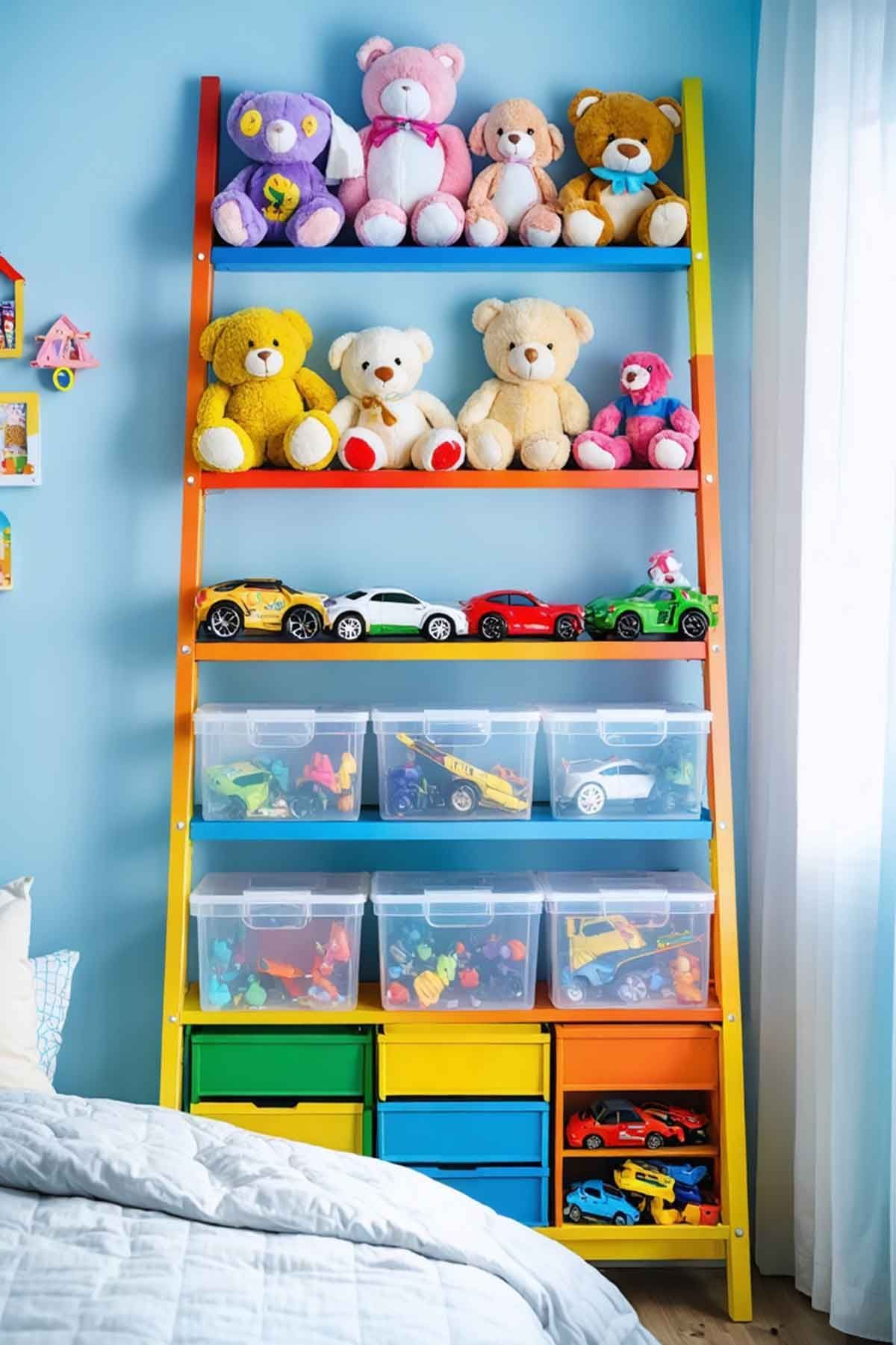
Essential Planning for Space Saving for Kids Bedrooms
Before looking for storage, smart parents plan carefully. They think about their child's needs and the room's layout. I learned the hard way that rushing into buying organizers without planning is a waste of money and can upset kids. The secret to successful space saving for kids bedrooms lies in understanding exactly what you're working with.
Begin by watching how your child uses their room for a week. You'll notice patterns you never saw before. See where they put their school bag, which toys they use every day, and where they like to do homework or be creative.
Assessing Your Child's Storage Needs
Parents should take notes and categorize everything in the room. Create separate lists for daily clothes, seasonal items, toys, books, art supplies, and special collections. This shows how much storage you need for each type of item.
Remember, your child's needs change as they grow. A 6-year-old's needs are different from a 12-year-old's. Think about what they'll outgrow in the next two years and plan for that.
Ask your child which items they value most. They often want their favourite things easy to reach. This helps you decide where to put their most precious items.
Measuring and Mapping Available Space
Use your measuring tape and make a detailed room map – this step is absolutely crucial for effective storage for children's bedrooms. Measure twice, buy once! Note the ceiling height, window placement, door swing, and any special features like alcoves or angled walls.
Australian bedrooms often have unique layouts, like sloped ceilings or awkward corners. These can be great for storage with the right planning. Mark these areas on your floor plan – they're often overlooked.
Make a simple sketch of where your child spends most of their time. This helps you place storage where it will be used, not just where it looks good. The best organized room works with your child's habits, not against them.
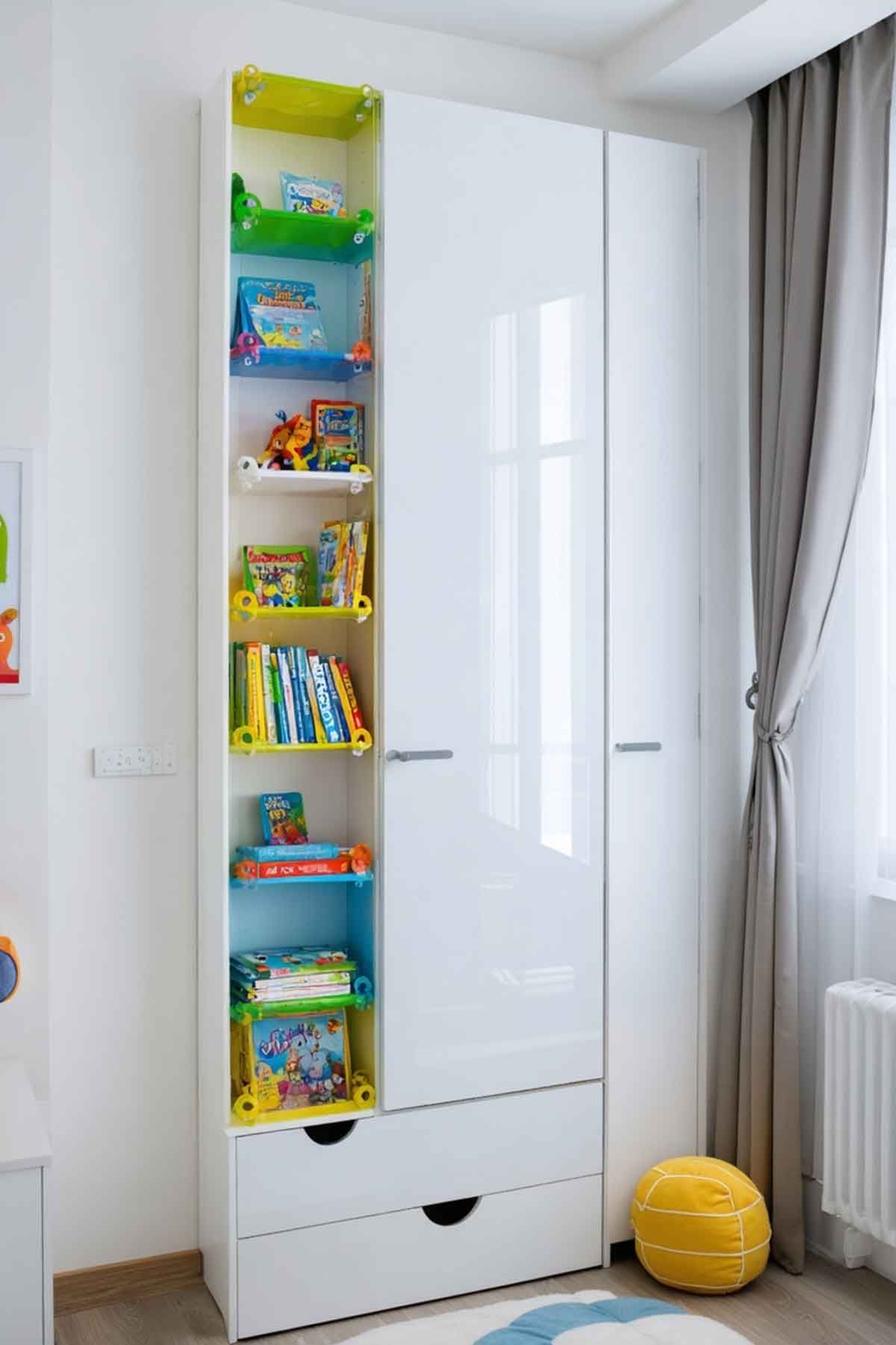
A small wardrobe with shelves for easy access of toys and games.
Trick 1: Maximize Vertical Wall Storage
Many parents overlook the power of vertical storage in kids' bedrooms. Walls are a huge untapped resource. By looking up, not just out, you can make rooms feel bigger.
Using every inch of wall space is key to great storage for kids' bedrooms. This approach means you don't lose play space to storage.
The best storage solutions are the ones that grow with your child and adapt to their changing needs over time.
Installing Floating Shelves and Cubbies
Place floating shelves at your child's height, not yours. For little ones, aim for 3-4 feet high. Older kids can handle shelves up to 5 feet.
Wall-mounted cubbies are like mini museums for your child's treasures. They keep collections tidy while showing them off. Pick cubbies with various sizes for books and small toys.
Pro tip: Install shelves along your room's roofline if it's slanted. This makes storage feel like it was made for your room.
Using Over-Door Hanging Organizers
The back of your child's bedroom door is prime real estate for storage. Over-door organizers are great for small items that disappear.
Clear pocket organizers are perfect for shoes, hair accessories, or art supplies. They make it easy to see what's inside, encouraging quick cleanups.
For heavier items, use sturdy hooks on organizers. These are great for backpacks, jackets, or sports gear that needs quick access.
Creating Gallery Walls with Storage
Turn gallery walls into kids bedrooms space saving spots by mixing art with storage. Picture ledges display books like art, keeping them easy to reach.
Put small floating shelves between photos for interest and storage. This makes organization look good and intentional.
Use wall-mounted magazine holders as book displays. They keep books organized and add a cool touch to the wall.
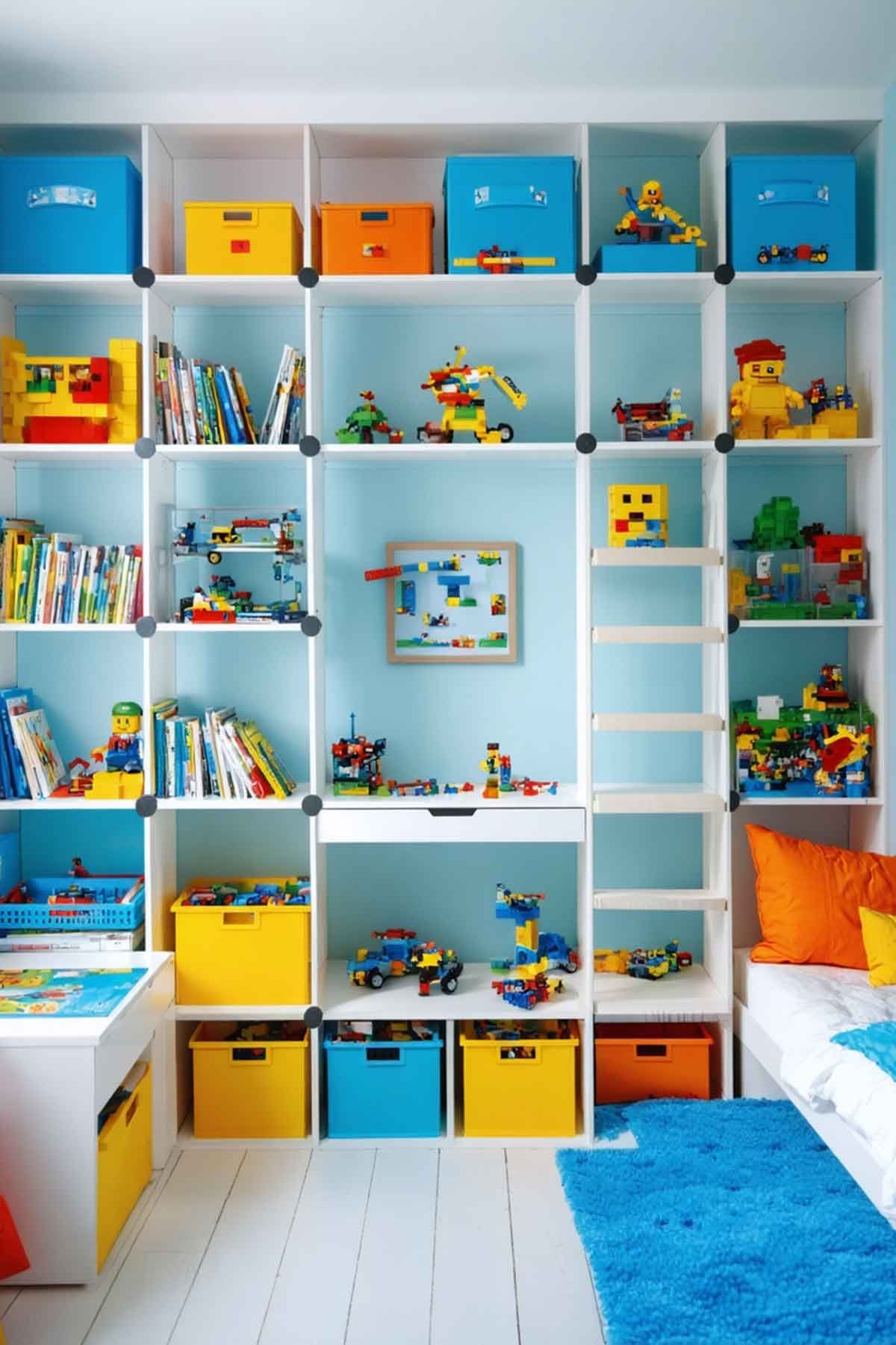
Trick 2: Transform Under-Bed Areas into Storage Goldmines
I'll never forget discovering the unused space under my kid's bed. It's like free storage real estate that most parents overlook. This area can hold toys and seasonal clothes, turning chaos into order.
Under-bed areas are a secret weapon against bedroom clutter. They're perfect for saving space, which is crucial in small Australian homes. Every square metre counts.
The key is choosing storage solutions that work with your child's habits, not against them.
Rolling Drawer Systems
Rolling drawer systems are a game-changer for under-bed organization. Invest in sturdy containers with proper casters that won't scratch your floors. They're lightweight and easy to move, making cleanup a breeze for kids.
These systems are accessible for kids. They can pull them out during playtime and slide them back when done. No more toys lost under the bed!
Look for drawers with clear fronts so kids can see their toys. Built-in handles make pulling easier for small hands. Choose models that fit your bed's height perfectly – measure twice, buy once!
Vacuum Storage Bags for Seasonal Items
Vacuum storage bags are great for seasonal storage. They can store an entire season's clothing in a small space. These bags compress bulky items like winter coats and holiday decorations into compact packages.
Here's a pro tip: label everything clearly and take photos of what's in each bag. You'll thank yourself later when you're looking for those Christmas pyjamas! Write the contents and date on both the bag and your phone.
Store heavier vacuum bags toward the back and lighter items toward the front. This makes it easier to rotate seasonal items. Check the bags every few months to ensure they're still sealed.
The magic happens when you combine both storage methods. Use rolling drawers for daily items and vacuum bags for seasonal storage. This creates a complete under-bed organization system that grows with your child's needs.
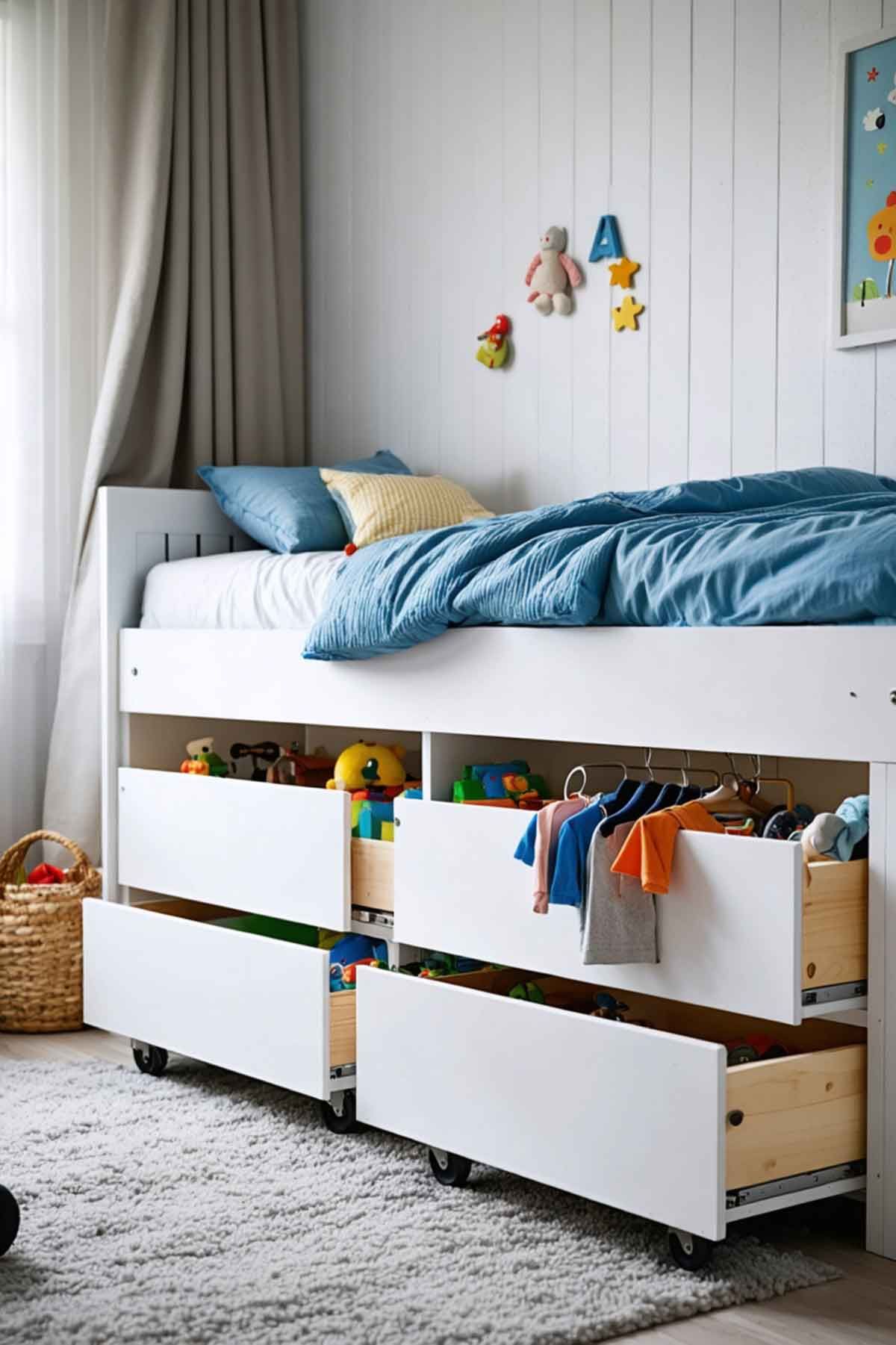
A great use of underbed storage
Trick 3: Invest in Multi-Functional Furniture
When space is tight, furniture that does more than one thing is key. It changes how you think about kids' bedroom space saving. The best choice isn't just about looks. It's about finding furniture that solves storage problems.
Multi-functional furniture is a must for today's families. It replaces the need for many storage units. Plus, it offers comfy, useful solutions that grow with your child.
The best furniture investments are pieces that serve at least two purposes, preferably three, and adapt to your child's changing needs over time.
Storage Beds and Ottoman Seating
Storage beds are my absolute favourite investment for any child's room. They have drawers underneath for toys, clothes, and more. This means you can ditch separate dressers.
Ottoman seating adds a lot to small spaces. Your child can use it as:
- Extra seating when friends visit
- A footrest during reading time
- A makeshift table for puzzles or crafts
- Hidden storage for blankets and bulky items
The hidden compartment in ottomans is great for odd items. It's perfect for storage for kids' bedrooms that don't fit elsewhere.
Convertible Desks and Play Tables
Convertible desks are pure genius. They change from play tables for toddlers to study desks for older kids. You're buying furniture that grows with your child.
These desks have built-in storage for art, books, and homework. They adjust in height, so you won't need a new desk as your child grows.
Some models have removable storage bins. These bins slide out for toy cleanup, then slide back in for a tidy workspace.
Modular Storage Cubes
Modular storage cubes are like adult building blocks for organizing spaces. They can change as your child's needs do. You can stack them high for vertical storage or spread them out for easy access.
The beauty of modular systems is their flexibility:
- Stack them vertically to maximize floor space
- Arrange horizontally as a room divider
- Mix and match colors for visual appeal
- Add fabric bins for concealed storage
- Reconfigure layouts as children grow
I suggest choosing cube systems with rounded edges for safety. Pick neutral colours that won't clash as your child's tastes change. These systems adapt, not become outdated.
Adding a double-rod system makes closets bigger right away. Kids' clothes are shorter, so a single rod wastes space.
Put the lower rod at your child's shoulder height. This lets them hang their clothes by themselves. The upper rod is for longer items, like dresses, that adults can handle.
You can find adjustable double-rod systems for under $50 at most hardware stores. They double your hanging space and teach kids to be independent. Make sure both rods are strong enough for little hands.
Drawer Dividers and Shoe Organizers
Drawer dividers are essential for storage for kids' bedrooms. Without them, drawers get messy and finding socks is hard.
I like adjustable dividers that grow with your child. They keep clothes like socks and underwear organized. Bamboo dividers are great in Australia because they handle humidity well.
Shoe organizers are also key. Clear pocket organizers on closet doors are perfect for shoes, accessories, or toys. They make it easy for kids to see what's inside, so they clean up faster.
| Organization Solution | Best Age Range | Storage Capacity | Independence Level | Average Cost (AUD) |
|---|---|---|---|---|
| Double-Rod System | 3-12 years | Doubles hanging space | High | $40-80 |
| Adjustable Drawer Dividers | 2-16 years | Organizes small items | Medium | $15-35 |
| Clear Shoe Organizers | 4-14 years | 12-24 compartments | High | $20-45 |
| Hanging Shelf Units | 5-15 years | 5-7 shelves | Medium | $25-60 |
The aim is to make the system so simple that kids can keep it tidy by themselves. When they can see everything and put things away easily, they're more likely to keep their closet neat.
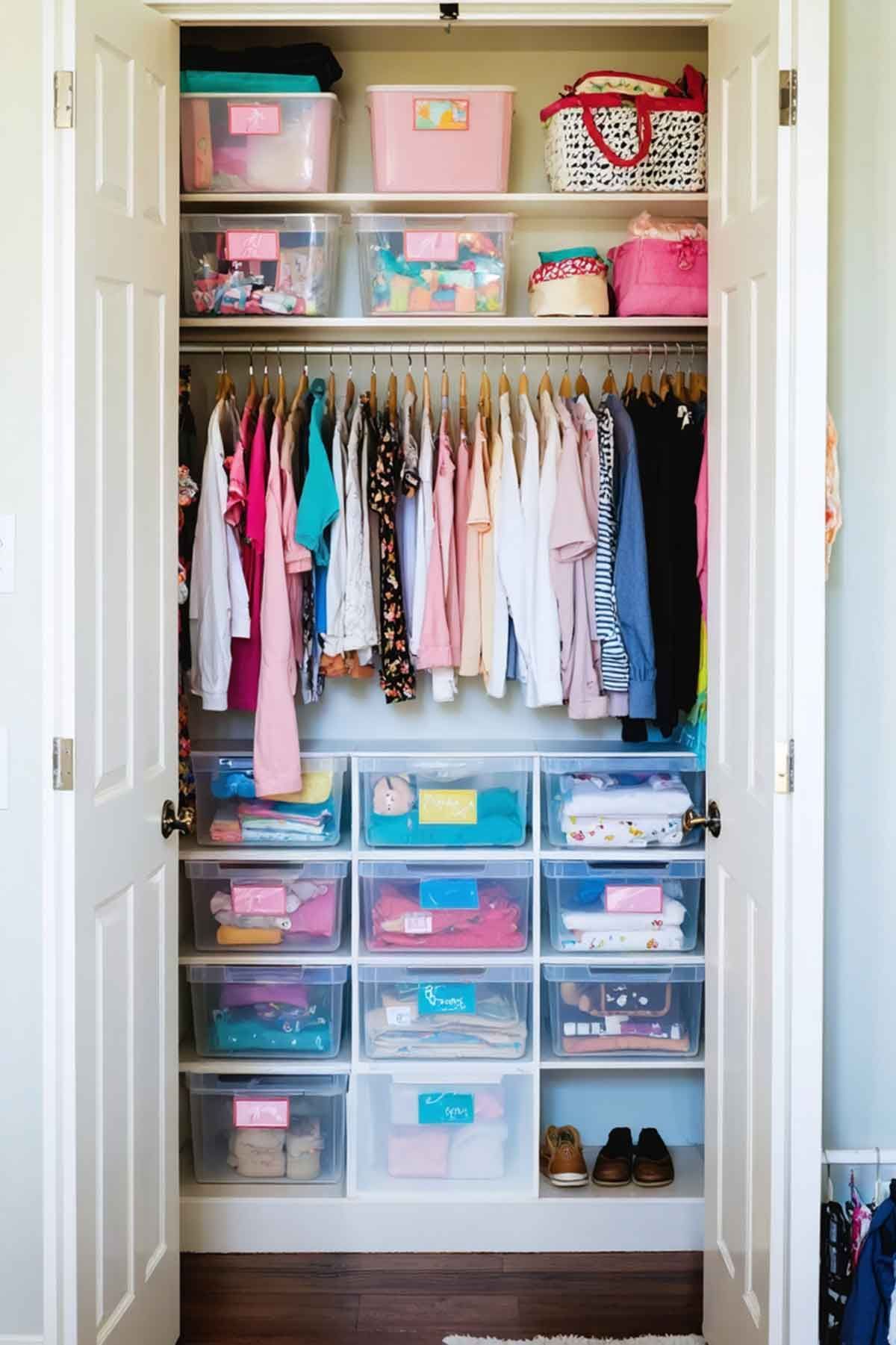
Trick 5: Utilize Every Corner and Nook
Those awkward spaces everyone ignores can become your secret weapon for space saving for kids' bedrooms. I've found that the most challenging areas often become the most loved features once they have a purpose.
Every room has dead zones that need creative solutions. That weird corner where nothing fits? The odd alcove under the stairs? These forgotten spaces are full of potential for clever storage.
Corner Shelving Solutions
Corner shelving units can turn wasted space into useful storage areas. I always tell parents to pick units made for corners, not regular shelves in odd angles.
Floating corner shelves are great for showing off books, toys, and treasures. They follow your room's lines and add interest. Custom-built corner units use every inch, with both open and closed storage.
Think about using corner organizers that spin for easy access. Kids love spinning these units to find their favorite books or games. It makes tidying up fun.
Window Seat Storage Benches
Window seats with built-in storage are genius for Australian homes where natural light is key. I've seen families create cozy reading nooks that kids love, hiding seasonal items underneath.
These benches are great for seating, storage, and a special retreat. Lift-up lids reveal hidden compartments perfect for blankets, out-of-season clothes, or bulky toys.
Add cushions and throw pillows to make it inviting. Children naturally go there for quiet activities. The storage becomes invisible yet very useful.
Don't ignore architectural quirks like sloped ceilings or odd alcoves. These spaces can become the most cherished when transformed with creative storage. Think beyond traditional furniture and celebrate your room's unique character.
Smart corner use can greatly increase storage without taking up floor space. Every nook is a chance to organize while keeping your child's room looking good.
Best Storage Products for Australian Kids' Bedrooms
Helping families organize kids' bedrooms has shown me some top storage products. These items have stood out in our unique climate and lifestyle. They make a big difference in keeping bedrooms tidy.
IKEA's TROFAST system is a top pick for young kids. It's affordable, easy to customize, and has bins just right for toys. It grows with your child and holds up well. Plus, you can find replacement parts at IKEA.
Bunnings Warehouse rolling bins are great for under-bed storage. They're strong and handle kids' energy well. They fit Australian beds and are cheaper than imports.
Kmart's cube organizers offer great value. They're colourful and durable, lasting years in busy homes. Parents are often surprised by their quality.
The Container Store's elfa system is a worthwhile investment. It's more expensive but changes as your child grows. Families use it from toddler to teen years.
Australian brands like Temple & Webster offer stylish storage. Their products fit well with modern homes and save space in kids' bedrooms.
Clear storage containers are key – kids like to see what's inside. Sistema and Decor make top Australian options that last. They make it easy to find toys and clothes.
Repurposed wooden wine crates are a budget-friendly option. They're great for books, toys, or crafts and add charm to any room. You can find them for a few dollars at local bottle shops.
Metal locker units are perfect for older kids. Bunnings has several styles that give teens a sense of ownership. They're great for storing clothes and other items.
Remember, durability is more important than looks when picking storage for kids. Cheap, flimsy items can become expensive mistakes. Kids use their storage every day.
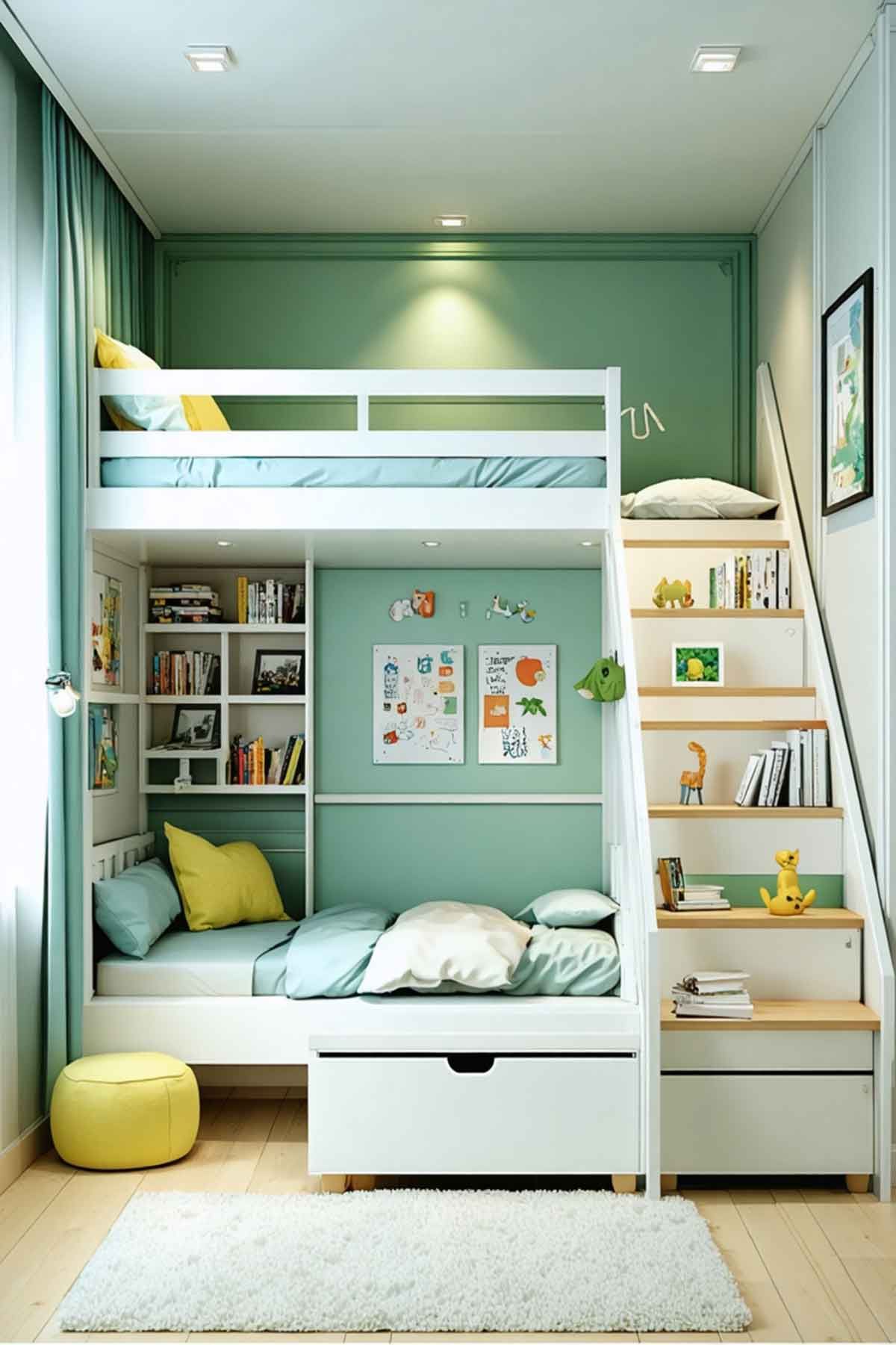
DIY Storage Solutions on a Budget
My favorite storage solutions cost less than a fancy coffee and changed kids' rooms for the better! DIY is great because it lets you make exactly what you need. It also teaches kids about creativity and being resourceful. Plus, you probably have most materials at home already.
Budget-friendly storage for children's bedrooms doesn't need fancy tools or carpentry skills. With a bit of imagination and weekend time, you can make custom solutions that fit your family's needs perfectly.
Repurposing Everyday Items
This is where the magic happens! Empty ice cream containers become perfect craft supply organizers with decorative paper wrapped around them. Kids get excited about organizing when their storage looks fun and colourful.
Cardboard boxes covered in contact paper or fabric create beautiful custom storage for almost nothing. Old suitcases become fantastic under-bed storage with wheels from the hardware store. Just ask your local bottle shop for wooden wine crates, they make great wall-mounted shelves that add character to any room.
My favourite budget hack: pool noodles cut into sections and placed in drawers create perfect dividers for socks and underwear! They're soft, colourful, and kids love the squishy texture.
Think about even the most obscure items. Simple metal garbage cans painted up can look amazing - and they have lids!
Simple Weekend Projects
Building basic storage doesn't have to scare you. A simple bookshelf using brackets and timber from Bunnings costs a fraction of store-bought options and takes just a few hours to complete.
Pegboards are fantastic for space saving in kids' bedrooms because they adapt as needs change. Mount one on the wall and customize it with hooks and small containers for art supplies, jewellery, or small toys. Kids can rearrange everything themselves!
Securing wooden crates together creates amazing bedside storage tables. Sand them lightly, add a coat of paint in your child's favourite colour, and stack them as needed for your space.
The beauty of DIY storage for children's bedrooms is involving your kids in creating their solutions. They're more likely to use and maintain systems they helped build. Plus, you're teaching valuable problem-solving skills while creating exactly what your family needs!
Teaching Kids to Maintain Their Organized Space
Teaching kids to keep their room tidy isn't about being perfect. It's about creating systems they can use and enjoy. The best space-saving solutions fail if kids don't keep them up.
- Make kids part of the organizing process from the start. When they help choose storage, they feel more connected to their space. Let them decide on bin colours or labels. This makes them excited to organize.
- Visual systems work well for kids of all ages. Use picture labels on bins for non-readers. Photos or drawings help them know where things go. This cuts down on confusion and excuses.
- Make cleaning fun by turning it into a game. Use a timer for "speed cleaning" and play music. This makes tidying up enjoyable.
- Set a rule like "one-toy-out, one-toy-away" to avoid clutter. This rule helps keep spaces tidy without limiting play. It can really change a messy room into a functional space.
- Start daily routines that become habits. Maybe tidy for 10 minutes before dinner or check the room before bedtime. Consistency is key, not how long you clean.
- Always praise kids for their cleaning efforts, no matter how small. Seeing them proud of their work encourages them to keep up the good work.
- It's okay if the room gets messy sometimes. The goal is to teach life skills, not keep everything perfect. It's about making it easy to get back to order.
- Focus on progress, not perfection. When kids see organizing as a skill they're learning, they're more curious. This mindset helps them succeed in the long run.
Safety Guidelines for Children's Bedroom Storage
For families organize kids' spaces, I stress safety above all. I've seen parents create beautiful storage that becomes a hazard. Your child's safety is more important than any organizational goal.
Wall anchoring is absolutely critical. Every tall piece of furniture needs proper wall anchors. In Australian homes, this is crucial due to seismic activity. I use heavy-duty wall anchors rated for at least twice the furniture's weight.
Weight distribution is key. Keep heavy items on lower shelves to avoid accidents. Light items like stuffed animals go up high. This simple rule prevents many accidents in kids' bedrooms.
The most organized room isn't worth a child's safety – always choose the safer option.
Sharp corners are dangerous in small spaces where kids move a lot. I recommend corner guards on all furniture edges. Choose rounded-edge pieces when possible for your safety.
Professional installation saves lives. Don't try electrical work or major wall modifications yourself. I've seen DIY disasters that could have been avoided. Hire qualified professionals for built-in storage systems.
Regular safety checks prevent problems. Tighten loose screws monthly. Check drawer slides and storage containers for damage. These quick checks take five minutes but prevent serious injuries.
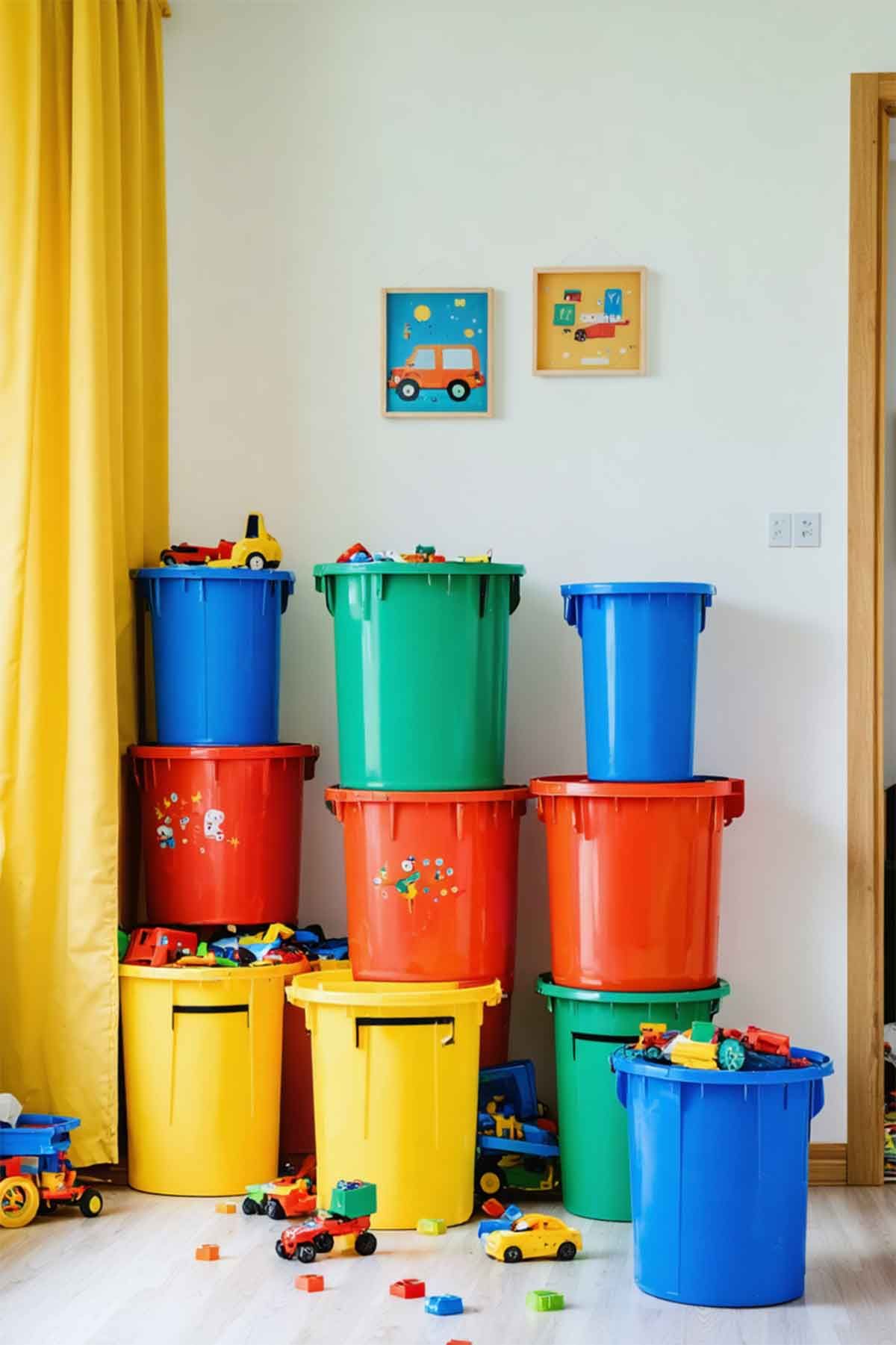
Teach your children about weight limits and safe climbing practices. They need to understand that storage cubes aren't jungle gyms. Make safety rules clear and consistent.
For bunk beds and loft storage, ensure railings meet Australian safety standards. The rails should be at least 16cm high and sturdy enough to support an adult's weight. Wobbly ladders are accidents waiting to happen.
Trust your instincts. If something feels unsafe, it probably is. I'd rather see a slightly less organized room than visit a child in the hospital. Your peace of mind is worth more than perfect storage for children's bedrooms.
Conclusion
Your child's bedroom transformation starts with just one small step. Choose the space-saving trick that feels most achievable right now. This could be installing floating shelves or organizing under-bed storage.
Small bedrooms across Australia show that limited space doesn't limit creativity. Families in Melbourne apartments and Sydney townhouses use these strategies to create beautiful spaces. Their children love these spaces.
When storage becomes part of daily routines, magic happens. Your child learns responsibility, and you gain peace of mind. Toys get homes, clothes stay organized, and bedtime becomes smoother.
Remember, every child is different. Some kids love color-coded systems, while others prefer simple, visual storage. Adjust these tricks to fit your child's personality and age.
Start small and build momentum. Install one floating shelf this weekend. Try vacuum storage bags for winter clothes next month. Your organized bedroom project doesn't need to happen overnight.
The investment in smart storage pays off quickly. Less time searching for lost items means more time for family activities. Easier cleanup routines reduce daily stress for everyone.
Your child deserves a peaceful sanctuary where imagination can flourish. These five tricks give you the roadmap. Now, it's time to create that special space your family will treasure for years to come.
FAQ
What's the biggest mistake parents make when organizing kids' bedroom space saving?
Parents often rush to buy storage without checking their child's needs first. It's important to observe how your child uses their space for a week. Also, don't forget about using wall space for storage.
How high should I install floating shelves in my child's bedroom?
Shelves should be at your child's eye level, not yours. For younger kids, place them between 3-4 feet high. For older kids, you can go higher. This makes storage easy for kids to use.
What's the best under-bed storage solution for Australian homes?
Rolling drawer systems are great. Bunnings Warehouse has sturdy bins that fit Australian beds well. Vacuum storage bags are also good for seasonal items. Choose solutions that fit your child's habits.
Which multi-functional furniture pieces offer the best value for storage for children's bedrooms?
Storage beds are a top choice because they save space and provide a bed. Ottoman seating is good for younger kids, offering seating and storage. Modular storage cubes are also great for changing needs.
How can I organize my child's closet so they can maintain it independently?
Make it easy for your child to see and reach everything. Use double-rod systems and adjustable drawer dividers. Add clear pocket organizers on closet doors. This way, your child can keep it tidy.
What are the best budget-friendly DIY storage solutions for kids' bedrooms?
You can find great DIY solutions that won't break the bank. Use plastic ice cream containers for crafts and cardboard boxes for storage. Wooden wine crates make great shelves. Pool noodles can be used as dividers.
How do I get my child to actually use the storage systems I create?
Involve your child in choosing storage solutions. This makes them feel responsible. Use picture labels and make cleaning up fun. The "one-toy-out, one-toy-away" rule helps keep things organized.
What safety considerations should I keep in mind for children's bedroom storage?
Secure tall furniture and shelves to walls. Keep heavy items low and use corner guards. Regularly check for loose screws and wear on moving parts.
Which storage products work best in Australian kids' bedrooms?
IKEA's TROFAST system is good for young kids. Kmart's cube organizers are affordable and kid-friendly. The Container Store's elfa system is a quality investment. Don't forget local brands like Temple & Webster.
How can I maximize storage in awkward corners and spaces?
Use corner shelving units to turn dead corners into useful spaces. Window seat storage benches offer cozy reading areas with hidden storage. Think creatively about using architectural features.
What's the most effective way to handle seasonal clothing storage in kids' bedrooms?
Vacuum storage bags are great for seasonal clothes. Label and photograph each bag for easy access later. Use rolling drawer systems for rotating storage.
How often should I reorganize my child's bedroom storage systems?
Reassess every six months as kids' needs change. Modular systems allow for easy adjustments. Watch for signs that the system needs tweaking.
More Kids Room Posts
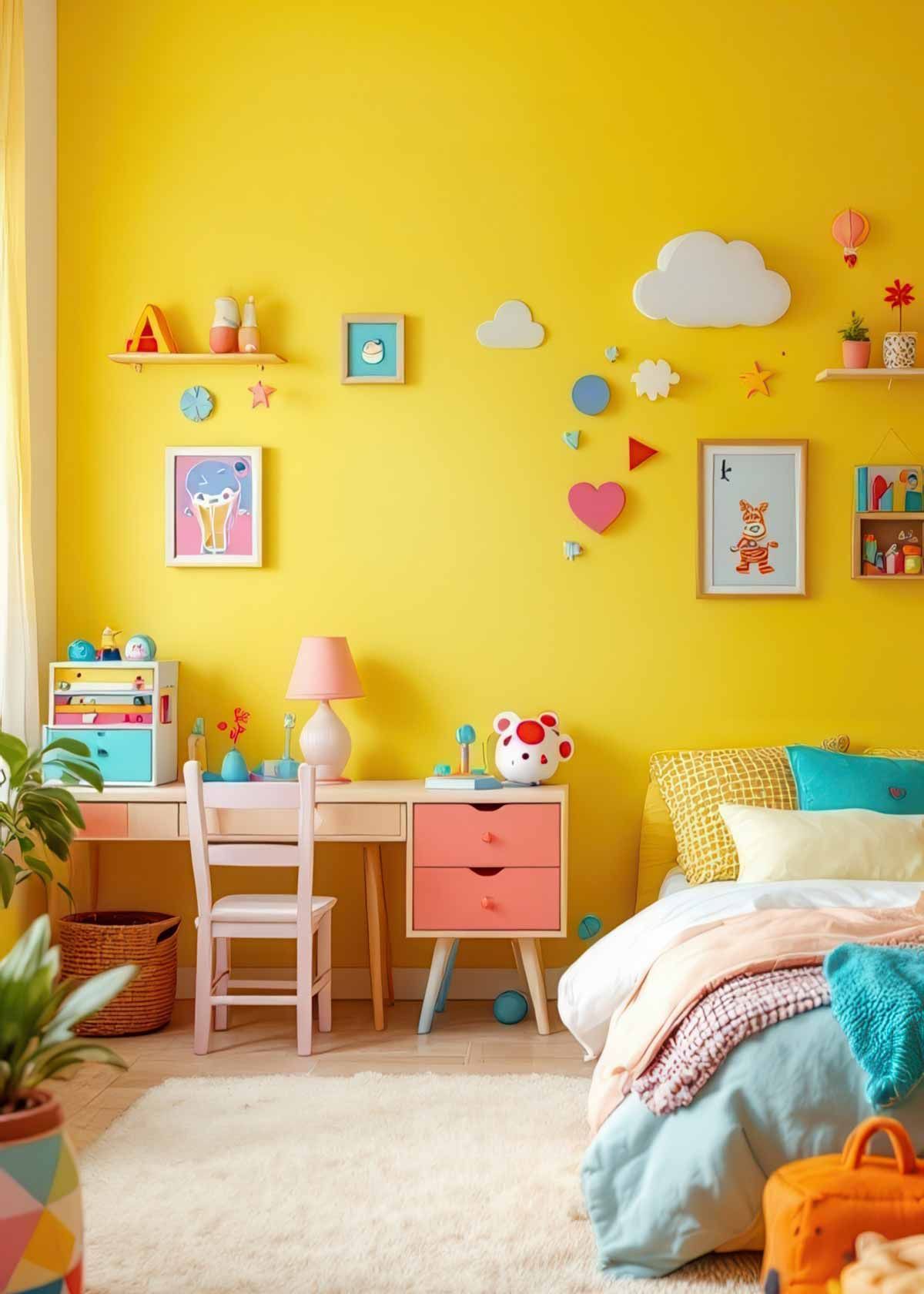

About The Author
I'm Channing and I am the driving force behind Platypus and Pine. I've had over 30 years of experience in designing, renovating and customising Australian homes.
I've used everything from aluminium to velvet as decor choices and love a wide variety of styles and themes.
My absolute favourite is Mid Century Modern and I was fortunate enough to spend 2 weeks in Palm Springs for Modernism week just last year.

